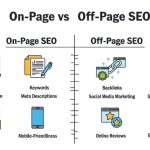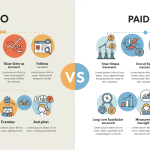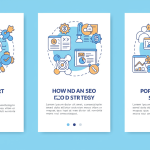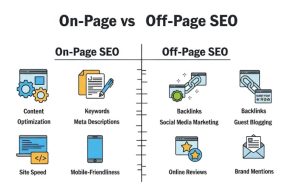
Most SEO advice sounds like a broken record: “create quality content,” “optimize your title tags,” “build backlinks.” While these fundamentals matter, they won’t give you the competitive edge you need when everyone else is doing the same thing.
The real game-changers lie in advanced techniques that most marketers either don’t know about or are too intimidated to implement. These strategies require more effort upfront, but they deliver results that compound over time.
If you’re ready to move beyond basic optimization and start seeing dramatic improvements in your search rankings, this guide will show you exactly how to get there.
Technical SEO Optimizations That Search Engines Love

Core Web Vitals Optimization
Google’s Core Web Vitals have become crucial ranking factors, yet many websites still struggle with these metrics. Focus on three key areas:
Largest Contentful Paint (LCP) should occur within 2.5 seconds. Optimize your largest above-the-fold element by compressing images, using modern formats like WebP, and implementing lazy loading for below-the-fold content.
First Input Delay (FID) measures interactivity. Reduce JavaScript execution time by splitting large bundles, removing unused code, and using web workers for heavy computational tasks.
Cumulative Layout Shift (CLS) prevents visual instability. Set explicit dimensions for images and videos, avoid inserting content above existing content, and use CSS transforms instead of properties that trigger layout changes.
Log File Analysis for Hidden Opportunities
Your server logs contain goldmines of information that most SEO professionals ignore. Analyze crawl patterns to identify:
Pages that Google crawls frequently but don’t rank well (optimization opportunities)
High-value pages that aren’t being crawled enough (internal linking issues)
Crawl budget waste on low-value pages (need for strategic no-indexing)
Tools like Screaming Frog Log File Analyser or Botify can help you uncover these insights and make data-driven decisions about your site architecture.
Content Strategies That Outrank Your Competition
Topic Clustering and Content Hubs
Instead of creating isolated articles, build comprehensive content ecosystems around your target topics. This approach establishes topical authority and captures more long-tail keywords.
Start by identifying your main topic pillars—broad subjects that align with your business goals. Then create supporting content that covers related subtopics, all internally linked to demonstrate the relationship between pieces.
For example, a main pillar page about “Email Marketing” might link to supporting articles about “Email Automation,” “Newsletter Design,” and “Email Analytics.” This structure helps search engines understand your expertise depth.
Content Gap Analysis Using Competitor Intelligence
Identify what your competitors rank for that you don’t by using tools like Ahrefs’ Content Gap feature or SEMrush’s Keyword Gap tool. Look for:
Keywords where multiple competitors rank in the top 10, but you don’t appear
High-volume terms related to your business that you’ve overlooked
Question-based keywords that suggest content opportunities
Create superior content that addresses these gaps while providing more comprehensive coverage than existing ranking pages.
Entity-Based Content Optimization
Search engines increasingly understand entities—people, places, things, and concepts—rather than just keywords. Optimize your content by:
Including related entities that Google associates with your main topic
Using structured data markup to clearly define entities on your pages
Creating content that covers entity relationships naturally within the text
Tools like Google’s Natural Language API can help you identify important entities within your topic space.
Link Building Beyond the Basics
Strategic Internal Link Optimization
Internal linking isn’t just about navigation—it’s about distributing PageRank and establishing content hierarchies. Use these advanced techniques:
Hub and Spoke Architecture: Create authoritative hub pages that link out to related content, then ensure those pages link back to the hub.
Strategic Anchor Text Distribution: Vary your internal link anchor text while maintaining relevance. Use exact match, partial match, branded, and generic anchors in natural proportions.
Link Velocity Management: Gradually increase internal links to new pages rather than immediately connecting them to your entire site structure.
Digital PR and HARO Maximization
Help a Reporter Out (HARO) and similar services offer opportunities for high-quality backlinks, but success requires a systematic approach:
Set up alerts for relevant queries in your industry
Craft personalized responses that provide genuine value
Include relevant statistics, quotes, or unique insights
Follow up professionally when your contributions are used
Build relationships with journalists over time rather than treating each interaction as transactional.
Advanced Technical Implementation
JavaScript SEO Optimization
As websites become more interactive, JavaScript SEO becomes critical. Ensure search engines can properly crawl and index your JavaScript-rendered content:
Use server-side rendering (SSR) or static site generation for critical pages
Implement proper loading states while content renders
Test how your pages appear in Google’s mobile-friendly test tool
Monitor your pages in Google Search Console for indexing issues
Schema Markup for Rich Results
Structured data can significantly improve your click-through rates by enabling rich snippets. Beyond basic markup, consider:
FAQ Schema for comprehensive question coverage
How-to Schema for instructional content
Product Schema for e-commerce pages
Local Business Schema for location-based businesses
Use Google’s Rich Results Test to validate your markup before deployment.
International SEO Implementation
If you serve multiple markets, advanced international SEO becomes crucial:
Implement proper hreflang tags to prevent duplicate content issues
Use appropriate URL structures (ccTLD, subdirectories, or subdomains)
Localize content beyond translation—consider cultural preferences and search behaviors
Monitor international performance separately in Google Search Console
Measuring Success and Continuous Improvement
Advanced Analytics Setup
Standard Google Analytics reports don’t provide enough depth for advanced SEO. Set up:
Custom segments for organic traffic by device, location, and user behavior
Goal tracking that connects SEO efforts to business outcomes
Search Console integration for query-level performance data
Heat mapping tools to understand user engagement with your content
Competitive Monitoring Systems
Stay ahead by monitoring competitor changes systematically:
Track competitor keyword rankings monthly
Monitor their new content publication schedules
Analyze their backlink acquisition patterns
Set up alerts for when they make significant site changes
Use tools like Ahrefs’ Site Explorer or SEMrush’s Position Tracking to automate much of this monitoring.
Your Next Steps to SEO Mastery
Advanced SEO requires patience, technical understanding, and consistent execution. Start with the techniques that align most closely with your current capabilities and business goals.
Focus on technical optimizations first—they often provide the biggest impact with the least ongoing maintenance. Then gradually expand into advanced content strategies and sophisticated link building approaches.
Remember that SEO success compounds over time. The advanced techniques you implement today will continue delivering results months and years into the future, giving you a sustainable competitive advantage that’s difficult for competitors to replicate quickly.
Begin with one or two techniques from this guide, master them completely, then expand your advanced SEO toolkit systematically. Your future search rankings will thank you.
Meta data
Meta title
Meta description


















No Comments